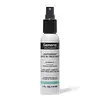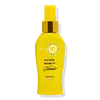What's inside
What's inside
 Key Ingredients
Key Ingredients

 Benefits
Benefits

 Concerns
Concerns

 Ingredients Side-by-side
Ingredients Side-by-side

Water
Skin ConditioningPropylene Glycol
HumectantCetearyl Alcohol
EmollientBehentrimonium Chloride
PreservativeNeopentyl Glycol Diheptanoate
EmollientParfum
MaskingQuaternium-80
Glycerin
HumectantIsododecane
EmollientDMDM Hydantoin
PreservativeMethylparaben
PreservativePanthenol
Skin ConditioningEthylparaben
PreservativeHydrolyzed Silk
HumectantButylene Glycol
HumectantHelianthus Annuus Seed
Skin ConditioningIodopropynyl Butylcarbamate
PreservativeAlthaea Officinalis Root Extract
Skin ConditioningAnthemis Nobilis Flower Extract
MaskingCamellia Oleifera Leaf Extract
AstringentCamellia Sinensis Leaf Extract
AntimicrobialEuterpe Oleracea Fruit Extract
Hydrolyzed Rice Protein
Skin ConditioningAlpha-Isomethyl Ionone
PerfumingBenzyl Alcohol
PerfumingBenzyl Benzoate
AntimicrobialCitronellol
PerfumingGeraniol
PerfumingHexyl Cinnamal
PerfumingHydroxycitronellol
PerfumingHydroxyisohexyl 3-Cyclohexene Carboxaldehyde
MaskingLinalool
PerfumingWater, Propylene Glycol, Cetearyl Alcohol, Behentrimonium Chloride, Neopentyl Glycol Diheptanoate, Parfum, Quaternium-80, Glycerin, Isododecane, DMDM Hydantoin, Methylparaben, Panthenol, Ethylparaben, Hydrolyzed Silk, Butylene Glycol, Helianthus Annuus Seed, Iodopropynyl Butylcarbamate, Althaea Officinalis Root Extract, Anthemis Nobilis Flower Extract, Camellia Oleifera Leaf Extract, Camellia Sinensis Leaf Extract, Euterpe Oleracea Fruit Extract, Hydrolyzed Rice Protein, Alpha-Isomethyl Ionone, Benzyl Alcohol, Benzyl Benzoate, Citronellol, Geraniol, Hexyl Cinnamal, Hydroxycitronellol, Hydroxyisohexyl 3-Cyclohexene Carboxaldehyde, Linalool
Water
Skin ConditioningPropylene Glycol
HumectantCetearyl Alcohol
EmollientCyclopentasiloxane
EmollientParfum
MaskingBehentrimonium Chloride
PreservativeButylene Glycol
HumectantCamellia Sinensis Leaf Extract
AntimicrobialCitric Acid
BufferingCitrus Limon Fruit Extract
MaskingEuterpe Oleracea Fruit Extract
Glycerin
HumectantHelianthus Annuus Extract
EmollientHydrolyzed Silk
HumectantIsopropyl Alcohol
SolventKeratin Amino Acids
Skin ConditioningLavandula Angustifolia Oil
MaskingPanthenol
Skin ConditioningQuaternium-80
Sodium Hydroxide
BufferingTetrasodium EDTA
Ethylparaben
PreservativeMethylparaben
PreservativePhenoxyethanol
PreservativePotassium Benzoate
PreservativePotassium Sorbate
PreservativePropylparaben
PreservativeSodium Benzoate
MaskingBenzyl Salicylate
PerfumingCitronellol
PerfumingGeraniol
PerfumingLimonene
PerfumingLinalool
PerfumingCI 17200
Cosmetic ColorantCI 42090
Cosmetic ColorantWater, Propylene Glycol, Cetearyl Alcohol, Cyclopentasiloxane, Parfum, Behentrimonium Chloride, Butylene Glycol, Camellia Sinensis Leaf Extract, Citric Acid, Citrus Limon Fruit Extract, Euterpe Oleracea Fruit Extract, Glycerin, Helianthus Annuus Extract, Hydrolyzed Silk, Isopropyl Alcohol, Keratin Amino Acids, Lavandula Angustifolia Oil, Panthenol, Quaternium-80, Sodium Hydroxide, Tetrasodium EDTA, Ethylparaben, Methylparaben, Phenoxyethanol, Potassium Benzoate, Potassium Sorbate, Propylparaben, Sodium Benzoate, Benzyl Salicylate, Citronellol, Geraniol, Limonene, Linalool, CI 17200, CI 42090
Ingredients Explained
These ingredients are found in both products.
Ingredients higher up in an ingredient list are typically present in a larger amount.
This ingredient is a preservative and often used for it's anti-static properties. You'll most likely see this ingredient in hair conditioners.
It does not cause irritation or sensitization in leave-on products at 1-5%.
Butylene Glycol (or BG) is used within cosmetic products for a few different reasons:
Overall, Butylene Glycol is a safe and well-rounded ingredient that works well with other ingredients.
Though this ingredient works well with most skin types, some people with sensitive skin may experience a reaction such as allergic rashes, closed comedones, or itchiness.
Learn more about Butylene GlycolCamellia Sinensis Leaf Extract is derived from the leaves of the tea plant. Black tea, green tea, and oolong tea are all harvested from this plant.
This ingredient has many skin benefits:
This ingredient contains polyphenols, a strong antioxidant. Antioxidants help fight off molecules that damage skin cells.
On top of that, the antioxidants in green tea neutralize free-radicals from the sun. This gives the skin some extra UV protection, but should not replace sunscreen.
Many components of tea have anti-inflammatory properties.
Polyphenols and L-theanine help soothe the skin and reduce irritation. The caffeine in Camellia Sinensis Leaf Extract helps calm inflamed blood vessels.
Other compounds found in tea include: Vitamin Bs, linoleic acid, magnesium, calcium, iron, and zinc.
Research has shown both drinking Camellia Sinensis Leaf Tea and applying it to the skin can help boost skin elasticity and hydration. Studies also show using tea extract may reduce sebum, or oil, production.
Learn more about Camellia Sinensis Leaf ExtractCetearyl alcohol is a mixture of two fatty alcohols: cetyl alcohol and stearyl alcohol. It is mainly used as an emulsifier. Emulsifiers help prevent the separation of oils and products. Due to its composition, it can also be used to thicken a product or help create foam.
Cetearyl alcohol is an emollient. Emollients help soothe and hydrate the skin by trapping moisture.
Studies show Cetearyl alcohol is non-toxic and non-irritating. The FDA allows products labeled "alcohol-free" to have fatty alcohols.
This ingredient is usually derived from plant oils such as palm, vegetable, or coconut oils. There is debate on whether this ingredient will cause acne.
Due to the fatty acid base, this ingredient may not be Malassezia folliculitis safe.
Learn more about Cetearyl AlcoholCitronellol is used to add fragrance/parfum to a product. It is often derived from plants such as roses. In fact, it can be found in many essential oils including geranium, lavender, neroli, and more. The scent of Citronellol is often described as "fresh, grassy, and citrus-like".
Since the Citronellol molecule is already unstable, Citronellol becomes irritating on the skin when exposed to air.
Citronellol is a modified terpene. Terpenes are unsaturated hydrocarbons found in plants. They make up the primary part of essential oils.
Citronellol is not able to be absorbed into deeper layers of the skin. It has low permeability,
Citronellol is also a natural insect repellent.
Learn more about CitronellolEthylparaben is a preservative, is a paraben, and is not reef safe.
This extract comes from the Cabbage Palm, AKA the Açaí berry! It has skin soothing, antioxidant, and anti-aging properties.
Acai berries are rich in antioxidants, including ferulic acid (The famous vitamin C stabilizer). Antioxidants protect your skin against damaging free-radical molecules.
You can also find carbohydrates, lipids, proteins, minerals, vitamin A, and Vitamin C in these berries.
Learn more about Euterpe Oleracea Fruit ExtractGeraniol is used to add fragrance/parfum to a product. It is the main component of citronellol. It is a monoterpenoid and an alcohol.
Monoterpenes are naturally found in many parts of different plants.
Geraniol can be found in many essential oils including Rose Oil and Citronella Oil. The scent of Geraniol is often described as "rose-like". Many foods also contain Geraniol for fruit flavoring.
Geraniol can irritate the skin when exposed to air. However, irritation depends on the ability of geraniol to penetrate into the skin. In general, geraniol is not able to penetrate skin easily.
Geraniol is colorless and has low water-solubility. However, it is soluble in common organic solvents.
Like citronellol, it is a natural insect repellent.
2,6-Octadien-1-ol, 3,7-dimethyl-, (2E)-
Learn more about GeraniolGlycerin is already naturally found in your skin. It helps moisturize and protect your skin.
A study from 2016 found glycerin to be more effective as a humectant than AHAs and hyaluronic acid.
As a humectant, it helps the skin stay hydrated by pulling moisture to your skin. The low molecular weight of glycerin allows it to pull moisture into the deeper layers of your skin.
Hydrated skin improves your skin barrier; Your skin barrier helps protect against irritants and bacteria.
Glycerin has also been found to have antimicrobial and antiviral properties. Due to these properties, glycerin is often used in wound and burn treatments.
In cosmetics, glycerin is usually derived from plants such as soybean or palm. However, it can also be sourced from animals, such as tallow or animal fat.
This ingredient is organic, colorless, odorless, and non-toxic.
Glycerin is the name for this ingredient in American English. British English uses Glycerol/Glycerine.
Learn more about GlycerinYou can find hydrolyzed silk in both haircare and skincare products. According to a manufacturer, it can help improve skin and hair hydration.
This ingredient is created by adding acid or enzymes to 'hydrolyze' silk protein.
Due to the origins of this ingredient, it is not vegan. Silk is an animal product from silkworms.
Depending on the source, this ingredient can be considered cruelty-free. It is created from left-over cocoons of silkworms. We recommend reaching out to the brand if you have questions about where their hydrolyzed silk comes from.
Learn more about Hydrolyzed SilkLinalool is a fragrance and helps add scent to products. It's derived from common plants such as cinnamon, mint, citrus, and lavender.
Like Limonene, this ingredient oxidizes when exposed to air. Oxidized linalool can cause allergies and skin sensitivity.
This ingredient has a scent that is floral, spicy tropical, and citrus-like.
Learn more about LinaloolMethylparaben is a preservative and is a paraben. It is used to prevent the growth of fungus, mold, and other harmful bacteria. Parabens are chemicals used as preservatives in both cosmetics and food.
Methylparaben can be synthetically created. It can also be found naturally in some fruits, such as blueberries.
Oftentimes, Methylparaben is combined with other parabens to help increase the shelf life.
The safety of Methylparaben is currently being studied. While ongoing studies are looking into the safety of parabens, the results have been very mixed. Some studies have not found Methylparaben to be harmful.
Learn more about MethylparabenPanthenol is a common ingredient that helps hydrate and soothe the skin. It is found naturally in our skin and hair.
There are two forms of panthenol: D and L.
D-panthenol is also known as dexpanthenol. Most cosmetics use dexpanthenol or a mixture of D and L-panthenol.
Panthenol is famous due to its ability to go deeper into the skin's layers. Using this ingredient has numerous pros (and no cons):
Like hyaluronic acid, panthenol is a humectant. Humectants are able to bind and hold large amounts of water to keep skin hydrated.
This ingredient works well for wound healing. It works by increasing tissue in the wound and helps close open wounds.
Once oxidized, panthenol converts to pantothenic acid. Panthothenic acid is found in all living cells.
This ingredient is also referred to as pro-vitamin B5.
Learn more about PanthenolParfum is a catch-all term for an ingredient or more that is used to give a scent to products.
Also called "fragrance", this ingredient can be a blend of hundreds of chemicals or plant oils. This means every product with "fragrance" or "parfum" in the ingredients list is a different mixture.
For instance, Habanolide is a proprietary trade name for a specific aroma chemical. When used as a fragrance ingredient in cosmetics, most aroma chemicals fall under the broad labeling category of “FRAGRANCE” or “PARFUM” according to EU and US regulations.
The term 'parfum' or 'fragrance' is not regulated in many countries. In many cases, it is up to the brand to define this term.
For instance, many brands choose to label themselves as "fragrance-free" because they are not using synthetic fragrances. However, their products may still contain ingredients such as essential oils that are considered a fragrance by INCI standards.
One example is Calendula flower extract. Calendula is an essential oil that still imparts a scent or 'fragrance'.
Depending on the blend, the ingredients in the mixture can cause allergies and sensitivities on the skin. Some ingredients that are known EU allergens include linalool and citronellol.
Parfum can also be used to mask or cover an unpleasant scent.
The bottom line is: not all fragrances/parfum/ingredients are created equally. If you are worried about fragrances, we recommend taking a closer look at an ingredient. And of course, we always recommend speaking with a professional.
Learn more about ParfumPropylene Glycol is an odorless, colorless liquid. As a humectant, it helps skin retain moisture. It also aids in delivering active ingredients.
Another role of this ingredient is preventing a product from melting or freezing. Propylene glycol also adds antimicrobrial properties to a product, elongating product lifespan.
This ingredient is considered an organic alcohol and commonly added into both cosmetics and foods.
Those with sensitive skin or conditions may develop a rash when using this ingredient.
Learn more about Propylene GlycolWe don't have a description for Quaternium-80 yet.
Water. It's the most common cosmetic ingredient of all. You'll usually see it at the top of ingredient lists, meaning that it makes up the largest part of the product.
So why is it so popular? Water most often acts as a solvent - this means that it helps dissolve other ingredients into the formulation.
You'll also recognize water as that liquid we all need to stay alive. If you see this, drink a glass of water. Stay hydrated!
Learn more about Water